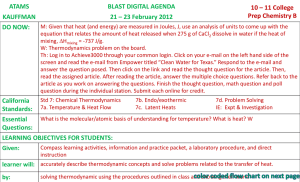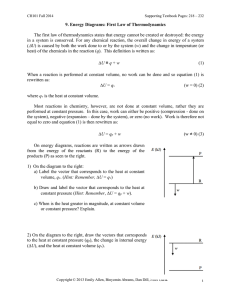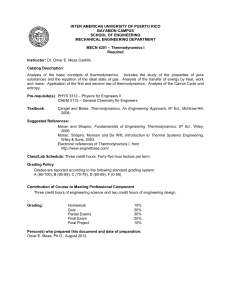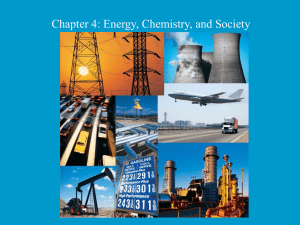Vasquez High School -- Chemistry B -- Test #1 -- Chapter 10 -
advertisement
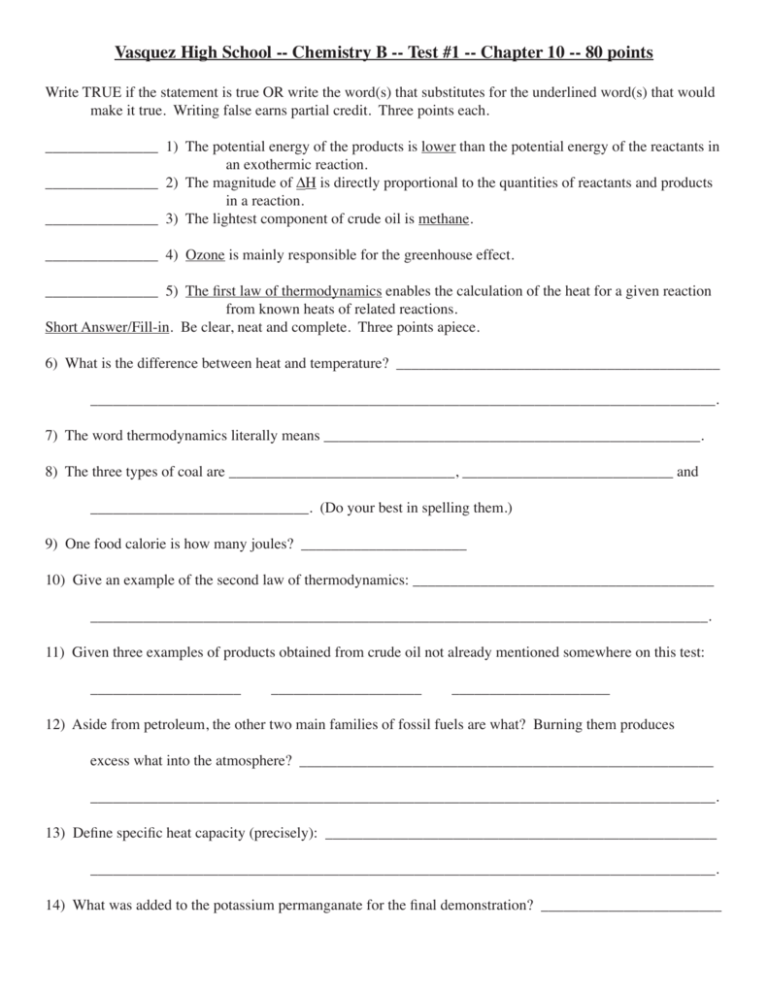
Vasquez High School -- Chemistry B -- Test #1 -- Chapter 10 -- 80 points Write TRUE if the statement is true OR write the word(s) that substitutes for the underlined word(s) that would make it true. Writing false earns partial credit. Three points each. _______________ 1) The potential energy of the products is lower than the potential energy of the reactants in an exothermic reaction. _______________ 2) The magnitude of DH is directly proportional to the quantities of reactants and products in a reaction. _______________ 3) The lightest component of crude oil is methane. _______________ 4) Ozone is mainly responsible for the greenhouse effect. _______________ 5) The first law of thermodynamics enables the calculation of the heat for a given reaction from known heats of related reactions. Short Answer/Fill-in. Be clear, neat and complete. Three points apiece. 6) What is the difference between heat and temperature? ___________________________________________ ___________________________________________________________________________________. 7) The word thermodynamics literally means __________________________________________________. 8) The three types of coal are ______________________________, ____________________________ and _____________________________. (Do your best in spelling them.) 9) One food calorie is how many joules? ______________________ 10) Give an example of the second law of thermodynamics: ________________________________________ __________________________________________________________________________________. 11) Given three examples of products obtained from crude oil not already mentioned somewhere on this test: ____________________ ____________________ _____________________ 12) Aside from petroleum, the other two main families of fossil fuels are what? Burning them produces excess what into the atmosphere? _______________________________________________________ ___________________________________________________________________________________. 13) Define specific heat capacity (precisely): ____________________________________________________ ___________________________________________________________________________________. 14) What was added to the potassium permanganate for the final demonstration? ________________________ 15) For one point each, write 1 if exothermic and 2 if endothermic: _____ a) When concentrated nitric acid is added to water, the solution gets very hot. _____ b) Rolling a large stone ball up a hill. _____ c) An ice cube left on the table melts. 16) At the right, draw a labelled diagram of a calorimeter. Five points. Calculation Section. Five points each. Write the appropriate equation. 17) How much heat is needed to raise 6.4 kg of water from 18 °C to 73 °C? 18) Given the equation: when 75 grams of oxygen is used? 3 2B + 2 O2 ==> B2 O3 DH = - 1273 kJ How much heat is given off 19) An unknown metal of mass 209.4 g requires 7785 J to heat it from 245 K to 384 K. What is the specific heat of the metal? 20) If it takes 2780 J of energy to warm 55 g of butanol by 19 °C, how much energy would be needed to warm 86 g of butanol by 28 °C? 21) Sulfur hexafluoride, one of the heaviest known gases, is used to insulate circuit breakers, transformers, and other electrical equipment including high voltage power lines. H2 S (g) + 4F2 (g) ==> 2HF (g) + SF6 DH = ??? Using the equations shown, determine the heat of reaction for the formation of sulfur hexafluoride. Ten points on this one. 1 1 H 2 (g) + 2 2 F2 (g) ==> HF (g) S (s) + 3F2 (g) ==> SF6 (g) H2 (g) + S (s) ==> H2 S (g) DH = - 273 kJ DH = - 1220 kJ DH = - 21 kJ 22) EXTRA CREDIT -- Three points -- Guessing is okay. If you were told that today’s temperature was 25 °C and tomorrow would be twice as hot, what would tomorrow’s temperature be?


